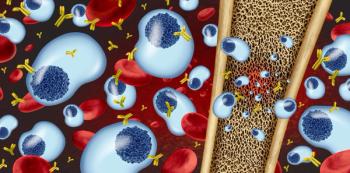
VMS and Sleep Disturbances Hinder Health-Related Quality of Life Outcomes When Transitioning to Menopause
Key Takeaways
- Persistent sleep disturbances and VMS during menopause are associated with decreased HRQoL, as shown by SWAN data.
- Both sleep disturbances and VMS negatively impact HRQoL, with anxiety and low income further worsening outcomes.
Research highlights the impact of sleep disturbances and vasomotor symptoms (VMS) on HRQoL in women transitioning to menopausal period, emphasizing the need for effective management.
This content was independently produced by Pharmacy Times in partnership with Bayer Healthcare.
Persistent sleep disturbance and vasomotor symptoms (VMS) in women transitioning into the menopause period are associated with worse health-related quality of life (HRQoL) outcomes, said authors of abstracts presented at The Menopause Society 2025 Annual Meeting. They emphasized that monitoring and addressing sleep disturbances and VMS can better help address symptoms, potentially improving HRQoL.1,2
For these abstracts, the investigators used data from the 1999 to 2008 follow-up visits from the Study of Women’s Health Across the Nation (SWAN). This repository is a multisite, multidisciplinary, longitudinal study of women’s health that was initially funded in 1994. The overall goal is to describe the natural history of menopausal transition and postmenopause, including biological, behavioral, and psychosocial characteristics. Additionally, SWAN focuses on menopause’s impact on age-related chronic diseases, such as diabetes, depression, bone loss and osteoporosis, cardiovascular disease, and physical and cognitive functioning.3,4
Abstract 1
The first abstract aimed to determine associations between persistent sleep disturbances and VMS with HRQoL in women experiencing menopause. Data from the first 11 annual follow-up visits (1999–2008) in SWAN. For 2 separate analyses, the investigators included women who provided information on self-reported sleep disturbances (waking up several times a night, trouble falling asleep, waking up earlier than planned on ≥ 3–4 nights per week in the past 2 weeks) at every study visit (n = 1176), or hot flashes or night sweats on 1 to 5 days in the past 2 weeks at every study visit (n = 1159).1
Additionally, each woman’s HRQoL was based on mean scores across visits on each of 3 Short-Form Health Survey (SF-36) subscales: role limitations due to physical health (RLPH), role limitations due to emotional problems (RLEP), and energy/fatigue (EF), where scores range from 0 to 100 (higher scores representing better HRQoL). The investigators counted the number of visits at which each woman self-reported experiencing VMS or sleep disturbances and evaluated any correlations with HRQoL, and associations with HRQoL using linear regression models adjusted as needed for certain confounders (eg, sociodemographics, mental health, lifestyle factors).1
According to the investigators, women reported sleep disturbances at a mean of 6.8 visits and VMS at a mean of 5.8 visits. They observed that both VMS (EF: −0.20; RLEP: −0.23; RLPH: −0.23) and sleep disturbances (EF: −0.34; RLEP: −0.26; RLPH: −0.26) were negatively correlated with HRQoL. In the regression model for sleep disturbances, for every 1 count increase in the number of visits with sleep disturbances, mean HRQoL scores decreased (RLPH: 0.94; RLEP: 0.75; EF: 0.95). This was also shown for VMS (RLPH: 0.70; RLEP: 0.64; EF: 0.44).1
Further, high anxiety and low income were the covariates that had the strongest associations with worse HRQoL across SF36 subscales in both models. For high anxiety the strongest associations were seen for RLEP, and for low income the strongest associations were seen for RLPH.1
Abstract 2
Similarly to the first abstract, the second also aimed to describe HRQoL in women across the menopausal transition and early postmenopause based on the presence of self-reported sleep disturbances and VMS, either alone or simultaneously. Data from 2066 participants from SWAN who reached natural menopause were included. The visits 5 years prior to and following the women’s final menstrual periods (FMP) were referred to as FMP-5 and FMP+5, respectively. Sleep disturbances, VMS, and HRQoL were assessed at each visit, with HRQoL being based on mean scores at each study visit on each of 3 SF-36 subscales: RLPH, RLEP, and EF.2
The findings indicated that HRQoL was the lowest in women with both VMS and sleep disturbances, followed by those with sleep disturbances only, and then VMS only. HRQoL was highest in women who did not report VMS or sleep disturbances. Additionally, among women with either VMS or sleep disturbances alone or both, HRQoL improved at FMP+4 and FMP+5. Regardless of symptoms, HRQoL was observed to be lower for EF than RLPH or RLEP.2
What This Means for Women's Health
The abstracts’ data show that among women in menopause transition, persistence of either sleep disturbances or VMS is associated with worse HRQoL-related outcomes. Although HRQoL appeared to improve several years after the FMP, the investigators recommended that continual monitoring and clear communication between women experiencing menopausal symptoms and health care professionals is necessary to manage symptoms effectively and to mitigate reductions in HRQoL.1,2
REFERENCES
1. Dinkel-Keuthage C, Nadimi M, Proenca CC, et al. P-78 – Persistent Burden of Sleep Disturbances and Vasomotor Symptoms in Women Experiencing Menopause: Associations with Health-Related Quality of Life. Presented at: The Menopause Society Annual Meeting; Orlando, Florida. October 21–25, 2025.
2. Maki P, Dinkel-Keuthage C, Nadimi M, et al. P-107 – Health-Related Quality of Life in Women with Sleep Disturbances and Vasomotor Symptoms Across the Menopausal Transition and Early Postmenopause. Presented at: The Menopause Society Annual Meeting; Orlando, Florida. October 21–25, 2025.
3. Swan – Study of Women’s Health Across the Nation. Investigating Health for Mid-Life and Older Women. Accessed October 22, 2025. https://www.swanstudy.org/
4. National Institutes of Health – dbGaP Genotypes and Phenotypes. Study of Women's Health Across the Nation (SWAN) Repository. Accessed October 22, 2025. https://www.ncbi.nlm.nih.gov/projects/gap/cgi-bin/study.cgi?study_id=phs001470.v1.p1
Newsletter
Stay informed on drug updates, treatment guidelines, and pharmacy practice trends—subscribe to Pharmacy Times for weekly clinical insights.




















































































































































































































